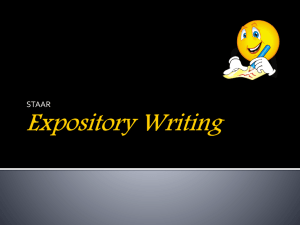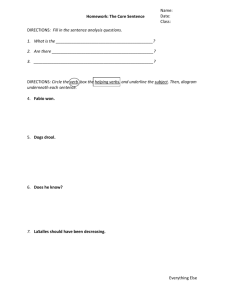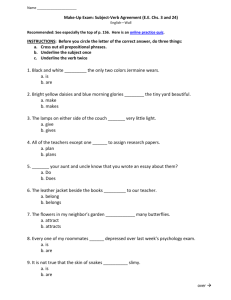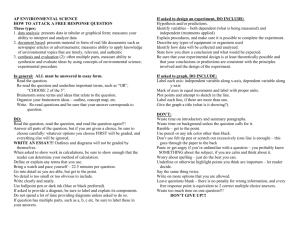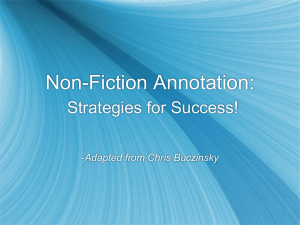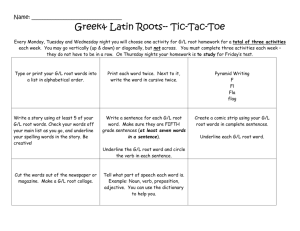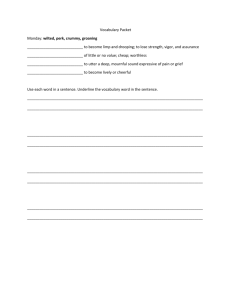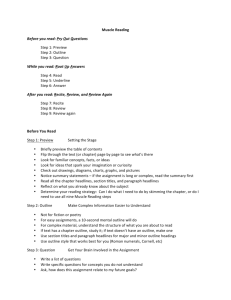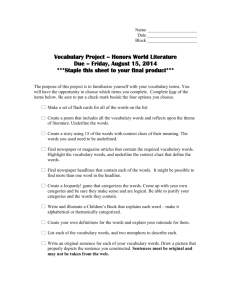using your textbook to your advantage
advertisement
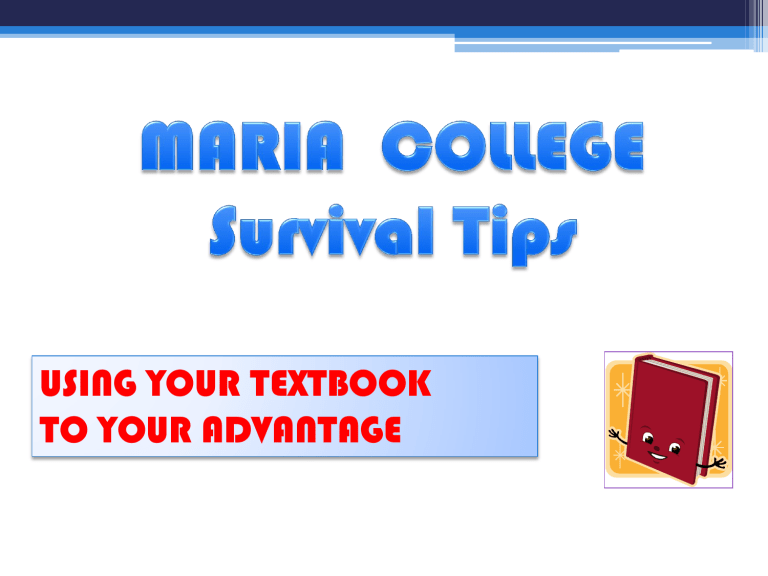
USING YOUR TEXTBOOK TO YOUR ADVANTAGE Active readers Positive attitude toward reading Read for ideas Ask questions to guide reading Schedule time for reading Have a purpose for reading Keep their own interest Control their concentration Use study systems/strategies Underline and annotate text Make graphics Relate what they read to prior knowledge & experience Review by reading other notes materials Seek help when necessary Know what is going on in class due to active reading Passive readers Negative attitude toward reading Read only words Read without questioning or thinking Read only if they have time Read because it was assigned Expect author to motivate them Easily distracted Don’t use any study system Don’t mark the text/mark too much Feel it is too much extra work See no connection between college and reading and work/life Review by re-reading entire chapter Do not seek help Feel lost in class Checking & changing Inefficient reading habits Evaluate your reading habits Moving your lips when you read Put your fingers on your lips to stop the motion. Vocalizing means pronouncing words in the voice box of the throat without making sounds. Place fingertips lightly against the vocal cord area of your throat. If you feel a vibration stop reading. Reading everything at the same speed Set reading rate according to your purpose for reading and the difficulty level of the material. Practice adjusting your rate to suit your material. The more difficult the material, the slower the rate. Regressing out of habit Use a card or paper to cover the text after you read it to prevent regressing. Reading one word at a time Use your eyes efficiently. Reading in idea-phrases speeds your reading and improves your understanding of what you have read. The best way to read faster is to practice reading just a little faster than is comfortable. Use the same type of materials each time you practice to provide the consistency needed for meaningful practice Provide the best conditions for reading. Choose a place where you won’t be distracted Increase your vocabulary by keeping a dictionary handy. Informational reading Purpose Strategy Reading to understand ideas and construct meaning Read carefully at a normal rate; First time you read a slow down for difficult parts; chapter. try to relate ideas and ask guide questions. Reading to find facts Scan read for dates, names, places, factual material Scan read for dates, names, places, factual material Reading to analyze Read slowly; give attention to every word; break sentences difficult material into parts and put the parts in your own words and summarize complex material When to use To look for an answer to a question that will be on a test, to check information your notes and to look over and review chapters. To read material that you don’t understand and to analyze complex or difficult material that you need to understand Look over the entire the text since there are several types of texts. Survey the title, copyright date, introduction (preface), table of contents, glossary, appendix, bibliography and index (author/subject). Setup Purpose What to look for Title Read title to trigger background What the chapter covers knowledge Goals/objectives Expected to learn Focus attention on what is important information Read 1st paragraph Introductory Central idea of chapter material Major headings Gives chapter breakdown Reveals chapter organization & subheadings Graphic aids Charts, graphs, diagrams Illustrates topics Key terms/words Calls attention to ideas & Bold face, italics, color Summary concepts Overview of chapter Questions/ problems Apply concepts Read to know what is Important What should have been Learned How to Mark Your Textbook Step 1 Read the entire section before you underline, highlight or mark anything in the text. Step 2 In the margin write key words or symbols that will serve as memory cues to call your attention to important information. Step 3 Put ideas and notes in your own words. This helps test your understanding and remembering the information. Step 4 Choose common symbols that you are familiar with and be consistent with their meaning and use. Def = definition Ex = example IM important point X = text question Use numbers (1,2,3,4,5) or letters (A,B,C,D,E) (a,b,c,d,e,) Step 5 Underline or highlight ONLY WORDS OR PHRASES not complete sentences. Use the SQ3R system developed by F. Robinson (1941). –before reading the text / chapter get an overview of the content and important parts Q Question – make up guide questions as you read. This activity helps keep your attention and monitors your comprehension R Read – actively read one section at a time and underline or make notes as you read R Recite – take time to pause to recite or repeat (silently or aloud) what you have read from your notes, study guides and specific markings wRite - a question and then answer the question S R Survey Review – immediately after reading Then review on a consistent basis to improve long term memory retention of the information. CRITICAL READING Uses interpretation, analysis, synthesis, and evaluation Interpretation – to discover meaning in a text, to determine what conclusions can be drawn about the various messages the text contains. Analysis - to examine the consistency & logic of the ideas and messages in a text; identifying assumptions, structure (inductive or deductive); supports. Synthesis & analysis involve the drawing together of results into a conclusion on which to base the worth or merit of a text. What to look for when reading 1. Take a pencil in your hand 2. Read the essay over once, quickly, looking for the main idea. 3. Check the meaning of unfamiliar words, scribble a brief definition. 4. Now re-read more slowly and carefully, this to find the single most important generalization (the thesis) the author makes. TOPIC Language – emotional or neutral Issues & Conclusions 5. Now re-read for structure looking Reasons for statement / for the main areas of the essay. beliefs What are the main points? Draw lines to the connections. Facts are direct evidence, 6. Within each structural of the actual areas find out the main point. Identify the topic sentence of each experience, paragraph. Underline the sentence. observation Sometimes the topic sentence can can be proven. be at the beginning, middle, or end of the paragraph. (most general sentence in paragraph) 7. With the author’s outlined ideas one should be able to follow his reasoning. A word or two in the margins and summing up the paragraphs, underline key transitional words or phases like (but, however, moreover, on the other hand, nevertheless.) 8. Now write out, the author’s thesis in your own words. 9. Author’s purpose? why write, what audience ,what assumptions already knew, or already believed, or both? Is audience hostile or friendly? 10. Now is the point to access the rhetorical techniques the author used in the essay. assumption to be proved. Opinion based on belief, judgment, feelings - one’s thoughts on a subject. Solid opinions, while based on facts are the writer’s views on the subject & not facts themselves. Faith is not subject to proof by its nature. Reading Difficult Material 1. Choose a reasonable amount of material and read it all 2. Scan to see how material is organized 3. Summary – read it 4. Read first for what you do understand quiz yourself, make connections, associations 5. Look up words 6. Organize your notes/Connect ideas 7. Take time to process what you have read. Then begin the next section. Learn from Multiple Sources provide framework to reinforce learning and elaboration, present ideas in different ways, sometimes offers a different point of view Lecture Original source material Handouts Fictional stories Electronic media audio/video, CAI, Internet Text – provide an overview (facts & viewpoints) provides a context for comparing and understanding other sources Course SOCIAL SCIENCES (anthropology, history, gerontology, government, sociology, psychology) Approach A. Learn facts and definitions B. Recognize common patterns (cause, effect, comparison, contrast) C. Build to concepts, generalizations (inductive thinking) D. Compare various theories, arguments E. Distinguish fact and opinion Reason Generate highlevel questions and answers Compare, contrast (analysis), synthesize and evaluate Course Approach HUMANITIES A. Determine perspective of author, (art, thinker, artist literature, B. Draw logical music, inferences, philosophy) implications C. Identify objectives for reading (style, theory, relationships) D. Keep track of personal reactions (marginal or separate notes) Reason A. Analyze, evaluate, interpret, in order to generate and answer questions B. Write papers and/or participate in class discussions Course MATHEMATICS Approach A. Know terms and symbols B. "Translate" abstract formulas C. Identify and contrast new theorems and formulas D. Contrast problems Reason A. Solve problems (application) B. Identify problemsolving strategies (comprehension) C. effectiveness of problem-solving strategies (evaluation) D. Compare types of problems (analysis) Course Approach NATURAL A. Read for common SCIENCES patterns (classification process description, (anatomy & factual statements, physiology, problem solving B. Define terms biology, C. Check chemistry, comprehension of terms physics) by giving examples, comparing, etc. D. Analyze sample problems Reason A. Solve problems (application) B. Compare types of problems (analysis) C. Describe processes (comprehension) D. Classify information (application)
